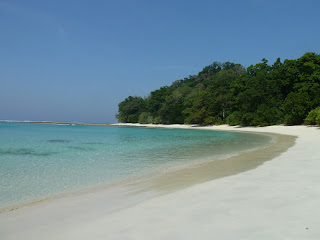The moonlight was so bright every mangrove leaf and twig formed a perfect shadow on the sand. The only sound was the scratch-scratch of hundreds of hermit crabs of every shape and size. We could see the whole length of the beach, from the river mouth on our right to the rocky mangrove-studded shore to our left. If a turtle was going to come ashore to nest, we would see her. Right place, right state of the tide, phase of moon, time of year and day....if only someone had told the turtles! We never saw a turtle nesting at Kalipur, although it was this possibility that had brought us up the Andaman chain to the jungle-covered island of North Andaman. That night waiting on the moonlit beach is still one of my favourite moments of the trip.
A few days earlier we arrived by plane from Chennai to the small but bustling capital of the Andamans, Port Blair. Horns toot just as loudly as mainland India and rickshaws vie to rip you off the most, but there's something a bit more tropical and relaxed about it all. The Andamans may be much closer to Indonesia, but they are still very Indian at heart. While in Port Blair I couldn't miss a visit to the brilliantly named Mount Harriet National Park (I didn't even get discounted entry), where brightly coloured butterflies flit between massive leaves, and the view of jungle and coast has been immortalised on the Indian 20 rupee note.
 |
| The jetty, Neil Island |
Luckily turtles weren't the only appeal of the North, where the highlight was having a real Robinson Crusoe experience on Craggy Island. Not a priest in sight, this is a deserted islet reached by swimming across the currents of a jellyfish infested channel! Unsurprisingly, we had the island and its white sand beach to ourselves and the snorkelling was well worth the effort. Like swimming in an aquarium- too many fish to take in, from clown fish defending their anemones, to the massive Napoleon wrasse with his bulging forehead and dozens of brightly coloured parrot fish munching on the coral.
Unfortunately, the previously abundant coral reefs of the Andamans have taken a massive hit in the last decade. First there was the earthquake and tsunami of Boxing Day 2004, which tilted the islands to such an extent that coral reefs rose out of the sea, causing a complete shift in the topography of the islands. Many beaches disappeared while others were formed, lumps of coral can be found far inland, and vast areas were flooded. Then an El Nino year and rise in the sea temperature caused the bleaching of much of the remaining coral. Most of the shallow coral reefs are now dead, and it's only in certain areas (like Craggy Island) with cold water currents, or by diving to 30m depth, that you can experience the variety and beauty of corals that used to be commonplace around the islands.
 |
| Forest devastated by the tsunami on Havelock |
 |
| The heavenly Neil's Cove, Havelock |
 |
| Eating out on Long Island |
The scuba diving from Havelock was fantastic, and although Karl hadn't dived for ten years we both got straight back into it. The deeper corals are brilliant here, from otherworldly funnel shaped sponges to soft feathers unfurling and swaying in the current and fan corals silhouetted against the blue, where big schools of barracudas circle above. With amazing visibility, perfect sea conditions and bath-warm water, it's clear why it's considered a world class diving destination.
Our time in the Andamans was far too short and there was so much more to explore, but with flights already booked we had to tear ourselves away. All in all it was probably the highlight of our time in India- a real backpacker's tropical paradise, but still secret enough that it felt like a proper adventure.
Harriet
Harriet